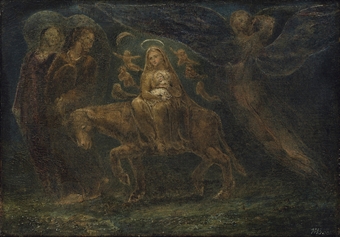Roger Fry, in his article Three Pictures in Tempera by William Blake in the Burlington Magazine (1904), later reprinted in the book Vision and Design, paid tribute to Blake as an artist. Fry recognised art as the vehicle for conveying thought and spirit through symbolic language in both verbal and visual images. One of the three temperas commented on in the article was Flight into Egypt.
 |
| Flight into Egypt
1799 |
"Blake's art indeed is a test case for our theories of aesthetics. It boldly makes the plea for art that it is a language for conveying impassioned thought and feeling, which takes up the objects of sense as a means to this end, owing them no allegiance and accepting from them only the service that they can render for that purpose. 'Poetry' says Blake, 'consists of bold, daring, and masterly conceptions; and shall painting be confined to the solid drudgery of facsimile representations of merely mortal and perishing substances, and not be, as poetry and music are, elevated into its own proper sphere of invention and visionary conception?' The theory that art appeals solely by the associated ideas of the natural object it imitates is easily refuted when we consider music and architecture; in those at least the appeal to the spirit is made directly in a language which has no other use than that of conveying its own proper ideas and feelings. But in pictorial art the fallacy that nature is the mistress instead of the servant seems almost ineradicable, and it is difficult to convince people the increased scientific investigation of phenomena, increased knowledge of how thing present themselves to our sight changes the mode, but does not necessarily increase the power, of pictorial expression...The essential power of pictorial as of all other arts lies in the use of a fundamental and universal symbolism, and whoever has the instinct for this can convey his ideas, though possessed of only the most rudimentary knowledge of the actual forms of nature; while he who has it not can by no accumulation of observed facts add anything to the spiritual treasure of mankind. Of this language of symbolic form in which the spirit communicates its most secret and indefinable impulses Blake was an eloquent and persuasive master. He could use it, too, to the most diverse ends; and though the sublimity which is based on dread came most readily to his mind,
...
To an artist like Blake, who wished to give visible form to profound and universal conceptions, a mythology was essential, and so intense was his imaginative grasp that he was able to recreate Christian and Hebrew mythology, giving them and essentially modern significance. He even attempted to invent a fresh and national mythology of which Albion was the protagonist. Whether he lacked the power, or whether the temper of his age was too contrary, the attempt was abortive. How different would have been the history of nineteenth-century art had Blake been able to impose on us a living mythology, held not necessarily as literally true, but as the only means of expressing in visible form our surmises about the eternal verities." Roger Fry - Page 144
Blake uses the inscriptions on the Laocoon engraving to expound his ideas about art and religion.
Laocoon, (E 273)
"Prayer is the Study of Art
Praise is the Practise of Art
Fasting &c. all relate to Art
The outward Ceremony is Antichrist
Without Unceasing Practise nothing can be done
Practise is Art If you leave off you are Lost
A Poet a Painter a Musician an Architect: the Man
Or Woman who is not one of these is not a Christian
You must leave Fathers & Mothers & Houses & Lands
if they stand in the way of ART
The unproductive Man is not a Christian"
.

No comments:
Post a Comment